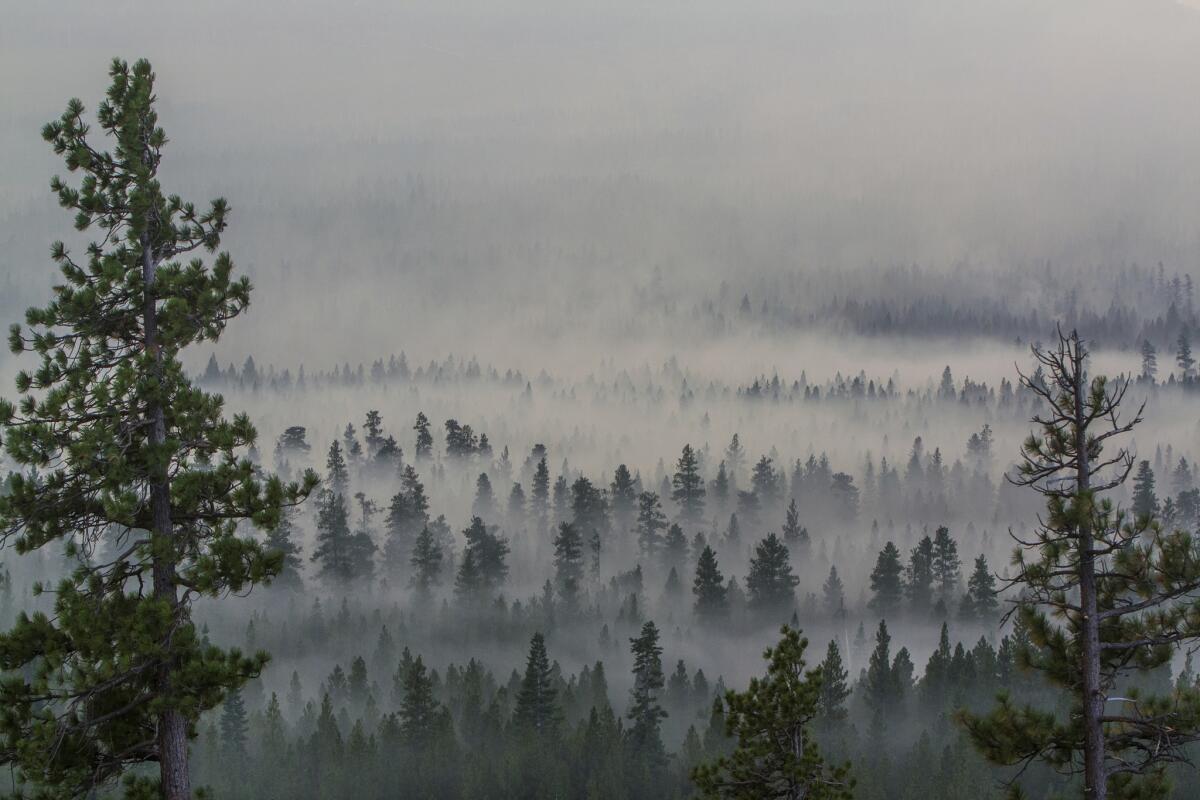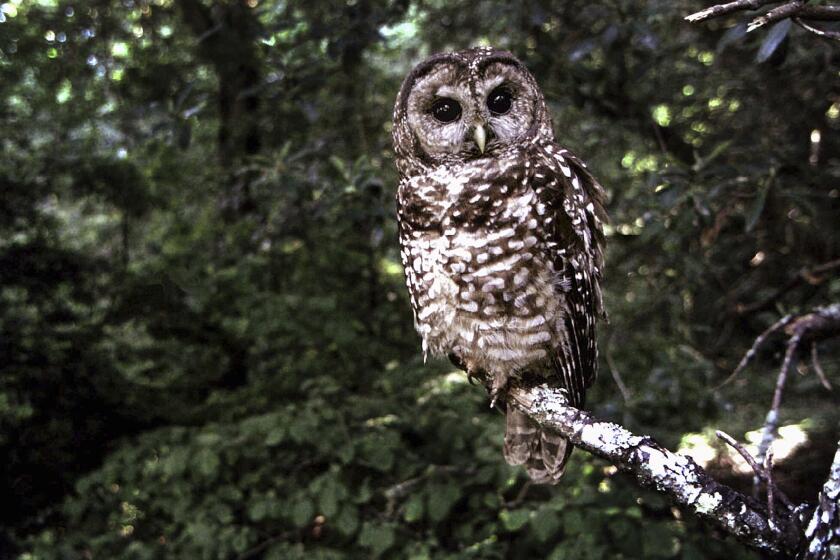As wildfires explode in the West, Forest Service can’t afford prevention efforts

- Share via
WASHINGTON — Residents of the densely wooded hillsides near Bend, Ore., are serious about fire.
They gather up fallen branches, prune trees and clear their gutters of pine needles. Their leaders in Deschutes County have banned wood-shake roofs and are considering adopting tougher building codes to make homes more fire-resistant. Every square mile of this growing county has been declared a wildfire hazard zone.
Yet for all of that effort, spurred by devastating wildfires that tore through central Oregon in the 1990s, Deschutes still has to worry about its neighbor — the U.S. Forest Service.
The county is nestled against Deschutes National Forest, where the federal agency has more than 250,000 acres’ worth of unfinished projects aimed at preventing catastrophic wildfire that are on hold because it doesn’t have enough funding.
“Each year we have literally hundreds of fires that start in the forest, and any one of those, on a bad day, could have a disastrous result,” said Ed Keith, county forester for Deschutes. “It boggles my mind to look at the fires in Oregon this year and how many millions we’ve spent and how much those dollars are needed to get this work done that’s waiting for money.”
It’s not just the one forest. Throughout California, Oregon and other Western states, the Forest Service has a growing backlog of millions of acres of forest management projects that are ready to go, requiring only funding and manpower to complete. This work involves thinning out small trees, clearing dry brush and intentionally setting beneficial fires, known as prescribed fire, to prevent flames from leaping out of forests and into nearby communities.
It’s work that’s more important than ever as climate change fuels larger and more destructive wildfires. Fast-moving blazes have roared through more than 5 million acres on the West Coast this year, killing 31 people in California.
But a century of focus on fire suppression and cuts to fire prevention programs have led the Forest Service to postpone work that experts say could prevent small fires from becoming conflagrations.
There have been cases of wildfires beating the federal government to the job. Conservation advocates say it’s become common to have fires erupt on public land where proposed work is either being planned or on hold for lack of funding. A Forest Service spokesman in Oregon said the agency had not begun to assess whether the fires that swept across the state last month had burned in places due for prevention work, but “it’s likely there were some impacts given the size,” he said.
The Forest Service’s backlog exposes an uncomfortable truth for the Trump administration. Although President Trump has repeatedly blamed deadly wildfires in California on the state’s forest management, neither his administration nor Congress has given the Forest Service adequate funding to clear dead trees and brush from federally owned land.
In fact, while actual spending levels rose slightly, Trump sought to cut funding for forest management for three years straight. In his 2021 proposed budget, he asked for a modest 4% increase.
Forest Service spokesperson Babete Anderson declined to say how many projects were currently on hold in the West.
“Many decisions are designed for work to be implemented in phases over multiple years,” Anderson wrote in an email to the Los Angeles Times. “This process is very fluid; as resources become available and conditions allow, these projects are completed over time.”
But the agency’s own data show that work is piling up. According to a Forest Service document shared with The Times by the Portland-based advocacy group Sustainable Northwest, in 2008 there were about 544,000 acres’ worth of prescribed fire and thinning projects that had accumulated just in Oregon and Washington state. By 2019, that figure had increased to more than 2.2 million — an area larger than Yellowstone National Park.
Even that number is probably an undercount, as the agency’s figures did not include all of the national parks in Washington. In an address to the Senate last month in which he urged more spending to reduce wildfire risks, Oregon Democratic Sen. Ron Wyden said his state’s current backlog exceeded 2 million acres.
In California, where more than half of the state’s 33 million acres of forested land is owned by the Forest Service, there are about 225,000 acres of prescribed fire projects that the agency either hasn’t finished or hasn’t begun.
Rep. Tom O’Halleran (D-Ariz.), whose sprawling district includes much of northern Arizona and overlaps parts of six national forests, said the record-breaking fires this year illustrated the dire consequences of further delay. About 800,000 acres in his district are waiting to be treated, he said, some of them close to communities and vital watersheds.
“We can’t wait for more deaths and more communities to be totally wiped off the map,” he said.
The backlog is the result of decades of federal regulations that encouraged the Forest Service to extinguish fires the moment they started, even if they were in remote, unpopulated areas. Without the natural cycle of wildfire — and amid accelerating climate change — Western forests became overgrown and dry, ideal conditions for explosive fire.
Wildfires grew larger, the fire season lengthened, and firefighting costs became uncontrollable. By 2017, those costs had consumed more than half of the agency’s budget, forcing it to raid its forest management funds to cover the bills.
Fire prevention work fell by the wayside, said Dylan Kruse, director of government affairs for Sustainable Northwest. Projects that had logging components got done because they were profitable for the Forest Service, he said, while work to clear tinder-dry vegetation sat, sometimes for years, waiting for money.
With no end in sight to the agency’s budget woes, the Forest Service has formed partnerships with some states to draw in a new source of revenue — state dollars. California lawmakers have committed to spend more than $1 billion from the state’s cap-and-trade program on forest management, some of which has gone to pay for work on federal lands.
Less conventional solutions are also being tried. An anonymous donor frustrated by the federal government’s inaction has given $2.5 million to fund wildfire prevention work around communities in southwest Oregon, where the fast-moving Almeda fire destroyed more than 2,000 homes last month in the neighboring towns of Talent and Phoenix.
It’s not just a money problem. Clearing underbrush and small trees takes a lot of people, it requires expertise, and some environmental groups question whether the Forest Service is prioritizing the most urgent projects rather than the least expensive. Prescribed fire also poses unique challenges. It can only be used when weather conditions are right, and the smoke it creates can irritate nearby residents.
Republicans have argued that the root problem is a decades-old environmental law, the National Environmental Policy Act, that they say entangles potentially lifesaving work in government bureaucracy. Yet the agency’s backlog is evidence that hundreds of projects have cleared the environmental review process and still remain unaccomplished.
Conservationists and wildfire policy experts agree that money is the main hurdle. In 2018, their hopes were raised when Congress passed legislation to change the way the Forest Service pays for firefighting. Instead of taking money from programs meant to prevent runaway fires, the agency would have access to billions of dollars in new disaster relief funding.
Cassandra Moseley, a University of Oregon professor who has studied wildfire management in the West, said that part of the deal was an understanding that it would free up nearly $500 million that could be used for fire prevention and forest restoration work.
But that’s not what happened. Trump didn’t propose shifting the money over to those programs, and Congress didn’t use the funding as intended.
“It means the fuel treatments can’t get done, the funding for research is decimated, and the recreation budgets continue to be decimated,” Moseley said. “That $500 million everybody thought was going to go to rebuilding the Forest Service seems to have evaporated into thin air.”
More to Read
Get the L.A. Times Politics newsletter
Deeply reported insights into legislation, politics and policy from Sacramento, Washington and beyond. In your inbox twice per week.
You may occasionally receive promotional content from the Los Angeles Times.










